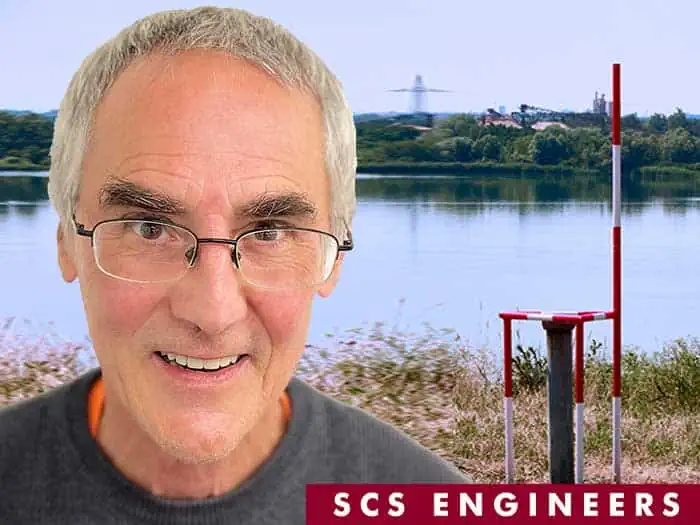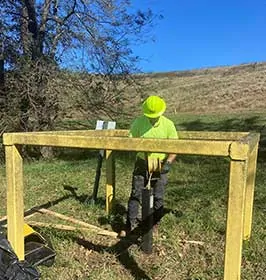


Meet Charles Hostetler, of SCS Engineers, at Session 4B Soil and Groundwater Characterization and Conceptualization on Tuesday, April 18, 3:30-5:50 for a discussion of CCR detection monitoring to minimize false positives.
CCR groundwater monitoring programs require routine detection monitoring around regulated units. Routine detection monitoring aims to identify situations where groundwater quality could be impacted by contaminants mobilized from CCR. Background data are collected to characterize the statistical distributions of groundwater quality parameters in the aquifer where there is no potential impact from regulated units. During operational, closure, and post-closure care activities, the same groundwater quality parameters are sampled periodically downgradient from the regulated unit and compared to these background data. Any statistically significant increases over background data spur an investigation of the potential result of CCR leachate impacting groundwater quality.
The procedure for designing and implementing a groundwater monitoring plan foresees that all routine detection monitoring programs will generate false positive results. The EPA’s Unified Guidance recommends that the design of monitoring plans minimize the site-wide false positive rate. For CCR detection monitoring programs, site-specific and regulatory requirements fix the number of well/parameter pairs and sampling frequencies, leaving the CCR permittee with two focus areas to minimize the site-wide false positive rate. The first is a robust background characterization that captures the site’s spatial and temporal variability. The second is a complete characterization of leachate composition, including unregulated constituents, and incorporating correlation into the statistical comparison to the background. These two focus areas can minimize costly assessment and corrective action activities.
Learn more about USWAG here. Register for USWAG here.
Additional Information located on CCR and Utilities is on the SCS website.
Did you miss the 2022 Annual GWPC & UIC Conference in Salt Lake City? We welcome you to view SCS Engineers’ presentation by Kacey Garber entitled “Sensitivity of Aquifer Chemistry to Changes in Carbon Dioxide Partial Pressure: Implications for Design of Groundwater Monitoring Protocols,” where Kacey discusses permitting requirements for groundwater monitoring for carbon sequestration and storage sites.
In her technical presentation, Kacey Garber of SCS Engineers discusses the great care taken in the design and operation of the injection of carbon compounds to ensure that the sequestration is effective and permanent. Each injection site also has permitting requirements for groundwater monitoring in any overlying aquifer as a protective measure. Because the injection and sequestration periods are long, CSS solutions need a cost-effective groundwater monitoring program with a robust sensitivity to detect any leakage. By establishing a groundwater monitoring protocol specific to the site, sensitive to changes in the partial pressure of carbon dioxide, and relatively insensitive to natural variability and hydrochemical facies changes, implementing optimal and cost-effective groundwater protection is possible. Using a case study, Kacey tells us how her team did this in detail.
Kacey Garber is an experienced groundwater project manager for active and closed landfills, including routine groundwater monitoring and statistical analyses; reports and permit applications; designing sampling and analysis plans; special groundwater studies; and conducting groundwater well construction planning and design.
SCS Engineers’ SCSeTools® platform and applications help facilities and companies operate more efficiently by continually gauging operational health and identify trends critical to operations and the environment.
SCS Technology Services®, the technology development practice within SCS Engineers, announces a new application for tracking and analyzing environmental data. The application expands the firm’s SCSeTools® platform, demonstrating its commitment to developing the most advanced data-driven technology in the environmental services industry.
Groundwater monitoring and compliance services are long-term and expensive responsibilities that generate enormous amounts of monitoring and laboratory data. SCS Groundwater™ is a tool to monitor and manage the data associated with operations and reporting requirements for various sites. Sites include active or closed landfills, plants, and impact sites such as former dry cleaners or industrial facilities.
The application also monitors and manages data effectively for clean groundwater applications such as groundwater basin management projects consistent with standard protocol under state and federal environmental compliance rules. SCS Groundwater™ collects and efficiently organizes groundwater monitoring and maintenance data providing those responsible for environmental compliance with a reliable, consistent, and cost-effective way to manage the large volume of information.
The application’s primary value is enabling users to set up a detailed monitoring plan for any number of events, including the sampling points to include and what analyses to perform at each point. Once the information upload is finished, the application checks incoming data against the plan to confirm all work is complete.
SCS Groundwater™ generates reporting components such as data tables, charts, graphs, and maps for compliance, reporting, and finding trends. For example, on a brownfield site, the compliance manager could upload historical monitoring data results, view the data trends over time, and then produce report tables and figures. Operators can also use the data in other applications for additional analysis or visualization.
SCS Engineers’ environmental solutions and technology directly result from our experience and dedication to industries responsible for safeguarding the environment as they deliver services and products. For information about SCS, visit the SCS eTools pages or enjoy our 50th Anniversary video to see the technology in action.
The SCSeTools® platform and applications help facilities operate more efficiently by continually gauging operational health and spot trends that help determine when and how to invest in infrastructure. Field staff, environmental compliance experts, brownfields, developers, and clients in the waste industry guide the technology designs. For additional information and demonstrations of these productivity-enhancing tools, please contact .
The events of 2020 have affected the economy, the way we conduct business, and even our social interactions. Now, more than ever, streamlining costs is key for public and private sector clients across the country. Enter groundwater monitoring projects.
Often overlooked as an opportunity to reduce costs, it’s an excellent place to start when examining the costly operational processes of a solid waste facility. Groundwater monitoring is often thought of as necessary for compliance requirements and overlooked when considering ways to reduce spending. However, the proactive review of all monitoring projects may offer monitoring reduction or even cessation opportunities.
SCS Engineers has successfully employed these strategies at several Florida landfills. For instance, in Marion County, the SCS team worked to get a cessation in landfill gas and groundwater monitoring at the Martel Closed Landfill. Hired to conduct routine post-closure monitoring, the team observed obvious trends in the data that were favorable to the County. If you consider that monitoring costs average $10,000 to $50,000 per year, the potential cost savings over ten years is $100,000 to 500,000.
Bottom line: you should take the initiative to ask a few simple questions to see if further examination is warranted. What if contaminants are naturally occurring? Is the data in the technical reports supporting conclusions that include reduction or cessation when appropriate? Are you simply meeting the minimum requirements of the permit without an eye on the future?
About the Author: SCS Project Director David Atteberry puts his 20+ years of environmental consulting and management experience to work for his clients. His technical experience includes geologic and hydrogeologic investigations involving hazardous waste, solid waste, environmental, and water supply. Dave’s technical areas of expertise include contamination assessments, remediation, site characterization, aquifer characterization, RCRA compliance, waste characterization, environmental due diligence, reserve budgeting, and field sampling techniques.
SCS Groundwater™ collects and efficiently organizes groundwater monitoring and maintenance data providing those responsible for environmental compliance with a reliable, consistent, and cost-effective way to manage, view, and assess large volumes of information.
The application’s primary value is enabling users to set up a detailed monitoring plan for any number of events, including the sampling points to include and what analyses to perform at each point. Once the information upload is complete, the application checks incoming data against the plan to determine if all work is completed.
Efficient and consistent data collection means better quality control, fewer violations, and less costly operations. The application is a relational data management system specifically designed for groundwater management. Learn about more benefits here.
Meet Brian Eigenberger of our Charlotte, NC office. Brian is an Associate Scientist and an Air Force Veteran recently joining the SCS Engineers team in August! Brian’s love for the outdoors sparked his interest in geology and environmental services, leading to his Bachelor of Science in Geology from the University of North Carolina in May 2019.
Brian joined the United States Air Force in September 2010, working as a maintenance scheduler for 23 F-15 fighter jets. His responsibilities were to track jet maintenance, reporting his findings to the production superintendent managing the aircraft unit, then creating maintenance schedules for each aircraft while tracking its flying hours. The work requires meticulous record-keeping and knowledge of the aircraft itself.

As an SCS Associate Scientist, using his USAF experience and degree, Brian now works in the office and the field. He observes landfill well installations, collects gas, soil, and liquid samples, and then prepares the scientific data findings for his clients. The information informs groundwater reports ensuring that water resources remain pristine and meet all local and federal compliance standards.
Hired during the COVID-19 pandemic, Brian said he feels lucky to work in a professional capacity on a technical team but that many of his peers are having trouble finding specialized positions. Brian had never been on a landfill before SCS. He feels the learning and mentoring bring new and exciting perspectives to his career. He knows there is much more to learn, but he is excited to be part of SCS Engineers.
Brian enjoys spending time with his golden retriever, Axel. He adopted Axel before joining the Air Force, and both were overjoyed at their reunion when he turned home from his service. The two frequently go hiking; another way Brian enjoys good company and the great outdoors!
The staff at SCS Engineers (SCS) has talked at length about how changing the parameters of a coal ash remediation project impacts the eventual outcome of that project. That involves not only the factors present at a particular site but also the regulatory environment in which that site operates, certainly as rules evolve regarding the disposal of coal combustion residuals (CCRs).
Two primary means of coal ash remediation are closure-in-place, or cap-in-place, of an existing coal ash storage site, and closure-by-removal. Closure-in-place involves dewatering the storage site, or impoundment, in effect converting from wet storage to dry storage of ash. A cover system is then used to prevent more water from entering the site.
Closure-by-removal involves dewatering of the coal ash, and then excavating it, and transporting it to a lined landfill or a recycling center.
“There are lots of technical reasons and site-specific factors that can influence a project’s outcome,” said Eric Nelson, vice president of SCS and an experienced engineer and hydrogeologist. “These might include the type and volume of CCR, the geologic setting [e.g., groundwater separation], presence and proximity of receptors [e.g., drinking water supply], and physical setting [e.g., constraints such as access, available space onsite for re-disposal, proximity/availability of offsite re-disposal airspace, etc.].”
Sherren Clark, an SCS team member with experience in civil engineering and environmental science, said “risk evaluation is a key component of remedy selection. A CCR unit undergoing an assessment of corrective measures [ACM] could be a 100-acre ash impoundment containing 30 feet of fly ash, but it also could be a 2-acre bottom ash pond. It could have numerous groundwater constituents exceeding drinking water standards by a significant margin, or it could have a single parameter slightly above the limit at a single well. And there could be water supply wells nearby in the same aquifer, or none for miles around. All of these factors play into the selection of a remedy that addresses the existing risks, without creating other negative impacts such as site disturbance, dust, or truck traffic.”
Tom Karwoski, a hydrogeologist and project manager for SCS who has designed and managed investigations and remediations at landfills as well as industrial, Superfund, and other waste storage sites, noted the challenges inherent to individual sites and stressed careful planning is needed to achieve the desired result. At some sites, “given the size and the nature of the impoundments, transport of CCR off-site may not be the best option.” When moving from the ACM to the remedy [selection], it’s extremely important to have multiple meetings with the client to set the schedule. Based on the way the [CCR] rule is written, things have to progress logically. There’s time available for careful planning. The last thing we want to do is start making assumptions without input from the client and other interested parties. Regulatory compliance and concern for the surrounding community and the environment are important to us and our clients.
“If the nature of the site in its current condition allows it, capping of the site will reduce surface water moving through the waste and significantly cut down on the risk of groundwater contamination,” Karwoski said. “At sites where you have CCRs that may be distributed across a site, to consolidate that onsite and then the cap will address CCRs impacting groundwater.”
Jennifer Robb, vice president and project director with SCS’s Solid Waste Services Division, and the company’s Groundwater Technical Advisor for the Mid-Atlantic region said her group has “done corrective measures for cobalt, arsenic, and thallium,” all contaminants found in coal ash. “There are some in situ bio-remediation that can be done, where basically you’re trying to alter the chemistry to immobilize the metal.” Jennifer noted that there are also more physical remedies where contaminated groundwater is extracted from the subsurface by pumping or the groundwater plume is contained or treated in-situ with the construction of “cut off trenches.”
Karwoski said, “we have no preconceived notions about what is best for all sites, but if you consolidate [waste] onsite and then cap, it will certainly take care of a lot of situations where you have CCRs impacting downgradient groundwater.” This approach may not be appropriate in every situation, but, if arrived at after thoughtfully navigating the remedy selection process defined in the current Federal CCR rules (40 CFR 257 Subpart D—Standards for the Disposal of Coal Combustion Residuals in Landfills and Surface Impoundments), should result in an approach that is effective based on the site-specific factors present.
Read last month’s blog “Many Factors Influence Remedies for CCR Control and Disposal.”
PFAS are also key components in aqueous film-forming foam (AFFF), which is used to fight petroleum-based fires at aviation and manufacturing facilities. For decades, AFFF containing PFAS has been used extensively at airports throughout the world to protect the safety of passengers, crew, and others. The FAA requires that commercial airports train with, calibrate equipment with, and use the best performing AFFF fire suppression systems. AFFF is required to be used at airports and must be certified to meet strict performance specifications, including those mandated by the U.S. Department of Defense Military Specifications.
Lynleigh Love and Chris Crosby of SCS Engineers discuss the risks and issues with PFAS-based firefighting foam used at airports. The authors cover the regulatory climate, contamination investigations, operational and environmental management and litigation, along with alternatives to using traditional AFFF. There are some possible alternatives that can mitigate health risks in your community.
Read this article to help inform your mitigation plan and strategies to minimize risk.
According to the U.S. Geological Survey Circular 1344, the United States uses 79.6 billion gallons per day of fresh groundwater for public supply, private supply, irrigation, livestock, manufacturing, mining, thermoelectric power, and other purposes. This blog is intended for businesses that must meet groundwater monitoring regulatory compliance according to EPA and state mandates, which are becoming increasingly stringent.
Have you had a regulatory compliance issue due to the condition of your groundwater monitoring wells or adequacy of your monitoring network? Are you confident compliance issues won’t arise in the future? Groundwater monitoring networks—including wells and dedicated sampling equipment—are often:
What if you managed your groundwater monitoring network like your other equipment assets? By taking a systematic asset management approach to maintaining your groundwater monitoring network you can:
Not concerned? Consider the likely results of the “if it ain’t really broke, don’t fix it” approach:
Regulatory Non-Compliance: Failure to comply with state and federal monitoring well regulations may result in a notice of non-compliance, fines, or legal action.
Repair and Maintenance Costs: Ignoring minor repairs and maintenance can lead to significant well repair or replacement costs. Simple repairs like lock replacement or ground surface seal repair are quick and low cost. Don’t let these minor items put you at risk for notification of non-compliance due to neglect. Other repairs such as protective casing or near-surface well casing repair may cost more but are a fraction of the cost of replacing a well that becomes unstable due to neglect.
Well Replacement Costs: Abandoning and replacing a single well that can no longer be repaired can cost $3,000 to $10,000+ depending on the depth and construction of the well.
As with many assets, you save time and money in the long run by addressing problems before they arise. So what does monitoring well asset management look like? It doesn’t have to be complicated, costly, or time-consuming. We recommend starting with a simple inventory following these basic steps:
1. Identify needed repairs and replacements of existing wells
2. Develop a plan to repair, replace, or abandon wells as needed
3. Identify deficiencies in the coverage of your well networks
Schedule inventory Steps 1-3 yearly. Download SCS Engineers’ useful well inspection checklist to record monitoring well conditions, identify well maintenance needs and identify the regulatory status of each well. Your trained staff or your environmental consultant can perform the yearly well inventory.
Contact SCS at for a groundwater expert near you.

About the Authors: Tom Karwoski, PG, has 30 years of experience as a hydrogeologist and project manager. He has designed and managed investigations and remediations at existing and proposed landfills; and industrial, Superfund, military, and petroleum sites. Mr. Karwoski was a hydrogeologist with the Wisconsin Department of Natural Resources prior to becoming an environmental consultant.

Meghan Blodgett, PG is a project professional with over eight years of experience in the environmental consulting field, including soil, groundwater, and soil vapor investigation and remediation; brownfield redevelopment; and solid waste landfill development. She is experienced in planning and performing soil and groundwater contamination investigations, monitoring well design and installation, hydraulic aquifer testing, and soil and groundwater sampling.